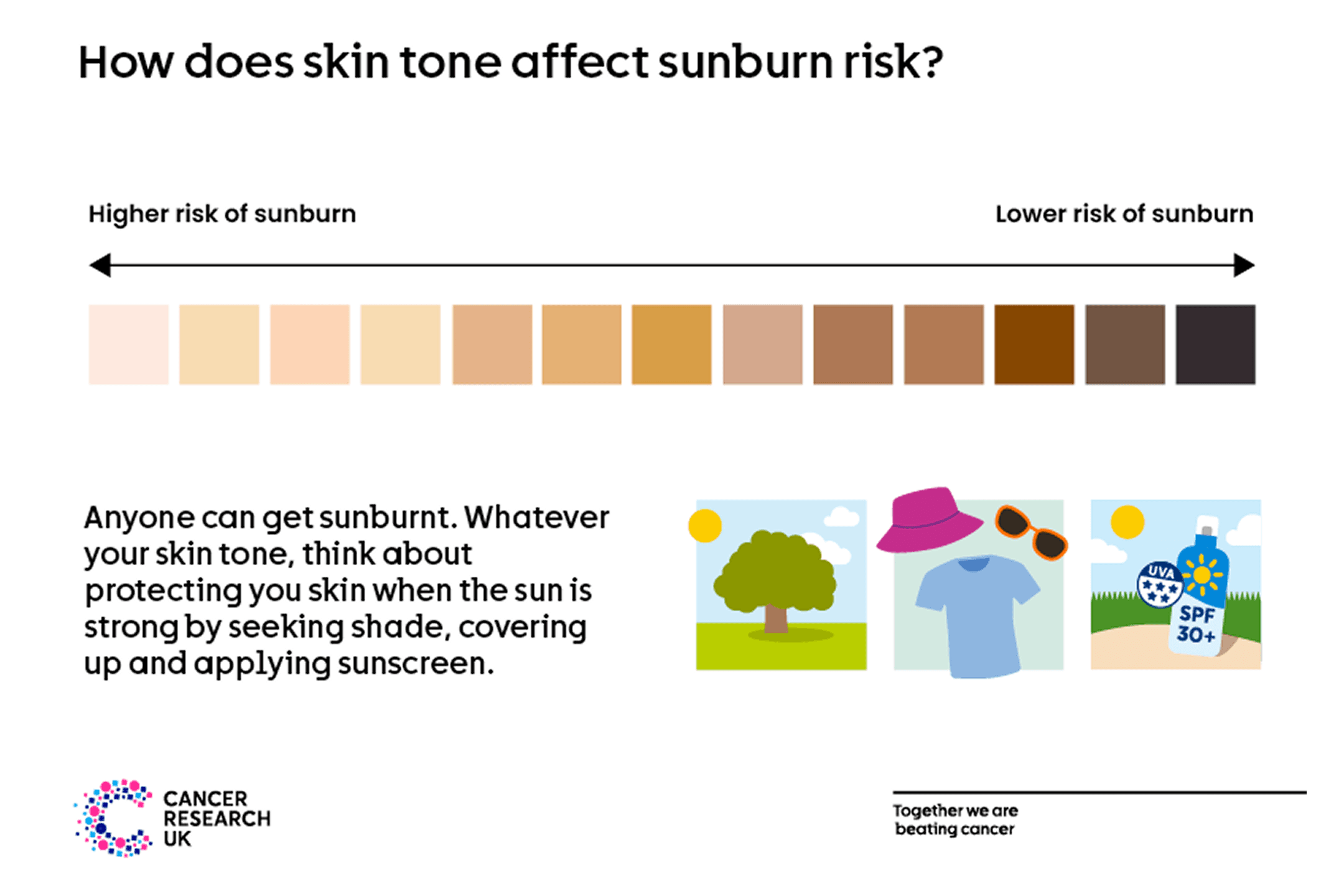Sun, UV and cancer
Ultraviolet (UV) radiation is a type of energy that is released naturally by the sun and artificially from sunbeds. Too much exposure to UV radiation is the main cause of skin cancer in the UK.

There are two main types of UV ray. Both types can damage our skin and cause skin cancer:
UVB reaches the outer layer of the skin (the epidermis) and causes most sunburns.
UVA reaches deeper into the inner layer of the skin (the dermis). It is responsible for ageing the skin but contributes less towards sunburn.
There is a third type of UV ray called UVC but it is completely blocked out by the ozone layer and doesn’t reach the earth's surface.
Too much UV radiation from the sun or sunbeds can damage the DNA in our skin cells. DNA tells our cells how to function. If enough DNA damage builds up over time, it can cause cells to grow out of control, which can lead to skin cancer.
Anyone can develop skin cancer. Some people may have a higher risk, including people who burn more easily.
It’s important to remember that skin damage doesn’t only happen on holiday or on hot, sunny days.
You can’t tell whether you are at risk of skin damage and sunburn from the temperature outside. This is because you can’t feel UV rays. The warmth you feel from the sun is a different type of ray, called infrared.
The UV index can tell you how strong the sun’s UV rays are each day. If the UV index is 3 (moderate) or more, you should consider protecting your skin from the sun.
Learn more about the UV index and your risk of sunburn.
While too much UV can cause skin damage, a bit of sun can help our bodies to make the vitamin D it needs for things like healthy bones. How much sun is needed for this is different for each person. But whatever your skin tone, there’s no need to sunbathe or risk getting sunburn to get vitamin D.
Read more about the sun and vitamin D.
Yes. Getting sunburnt increases your risk of cancer.
Sunburn is skin damage and your body’s response to try to repair it. It is a clear sign that the DNA in your skin cells has been damaged by too much UV radiation.
Getting sunburnt once doesn’t mean you will definitely get skin cancer. But the more times you get sunburnt the higher your risk of skin cancer.
That’s why it’s important to stay safe in the sun by:
Spending time in the shade, especially between 11am and 3pm in the UK.
Covering up with loose clothing, a wide brimmed hat and UV protection sunglasses.
Applying sunscreen with at least SPF30 and 4 or 5 stars, reapplying regularly and generously.
Anyone can get sunburnt but your skin tone affects your level of risk. People with lighter skin tones have a higher risk of sunburn and people with darker skin tones have a lower risk of sunburn.

Sunburn doesn’t have to be raw, peeling or blistering. For people with darker skin tones, your skin may feel irritated, tender or itchy. For people with lighter skin tones, it may also go pink or red in the sun.
If you notice any signs of sunburn, you should seek shade and cover up with clothing to help stop any more damage from happening. Putting on more sunscreen doesn’t mean you can stay out in the sun for longer.
Sunburns often hurt and using ‘after sun’ lotions can help sunburnt skin to feel better. However, this doesn’t repair any DNA damage.
Take the next time you head out into the sun as an opportunity to protect your skin and reduce your risk of sunburn.
How to enjoy the sun safelyYes. Skin cancer can grow down through the layers of the skin and spread to other parts of the body.
Remember, when skin cancer is found at an early stage, treatment is more likely to be successful. If you have noticed any unusual changes to your skin, speak to your doctor. It might be a mark or a mole that’s new or has changed, or a sore that doesn’t heal. It could also be changes like a dark area or line under a nail that’s not been caused by an injury.
Read more about skin cancer symptoms.
Last reviewed: 30 Nov 2023
Next review due: 30 Nov 2026
Questions about cancer? Call freephone 0808 800 40 40 from 9 to 5 - Monday to Friday. Alternatively, you can email us.